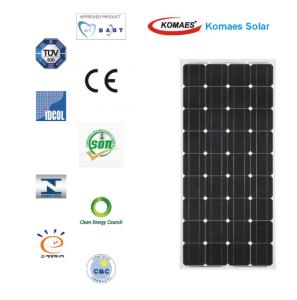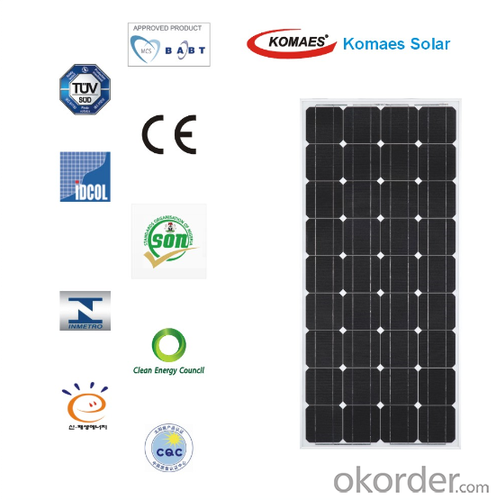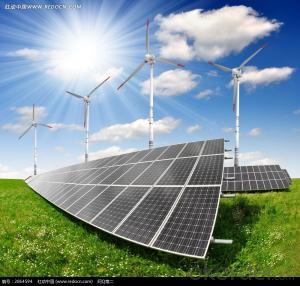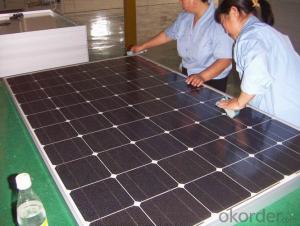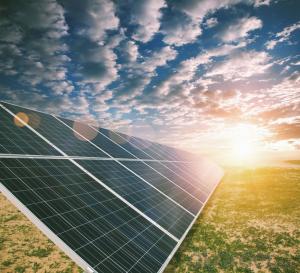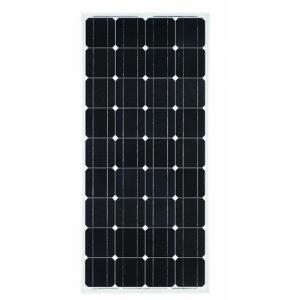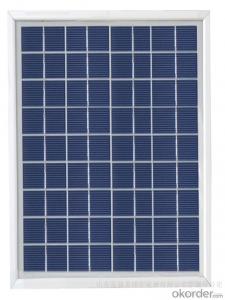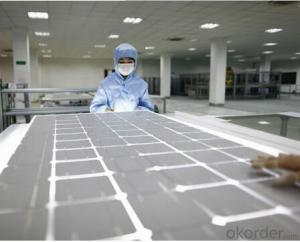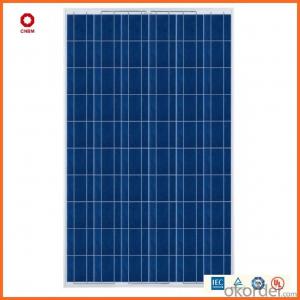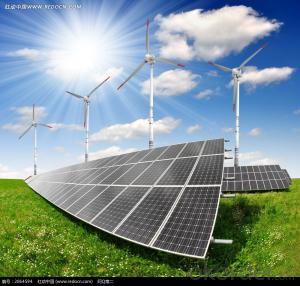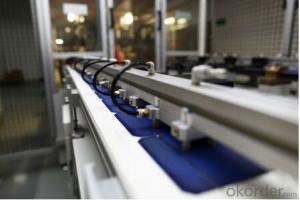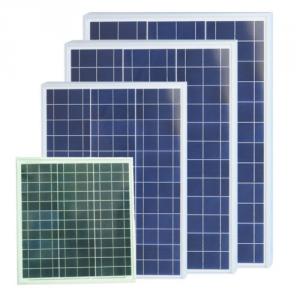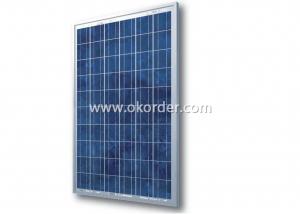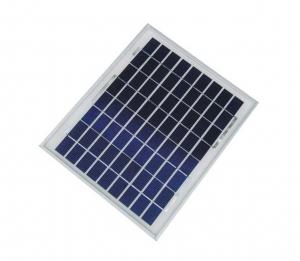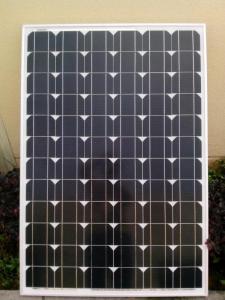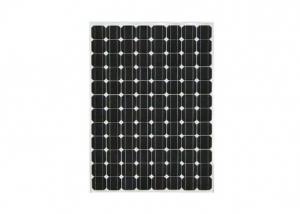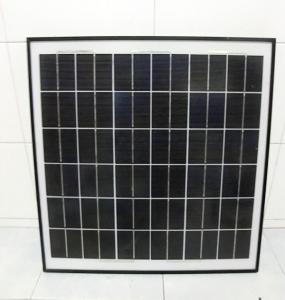Monocrystalline Solar Panels 150W with TUV IEC MCS INMETRO IDCOL SONCAP
- Loading Port:
- China main port
- Payment Terms:
- TT or LC
- Min Order Qty:
- 20000 watt
- Supply Capability:
- 10000000 watt/month
OKorder Service Pledge
OKorder Financial Service
You Might Also Like
1. Structure of Solar Panel 150W with TUV IEC MCS INMETRO IDCOL SONCAP Certificates Description
Solar panel refers either to a photovoltaics (PV) module, a solar hot water panel, or to a set of solar photovoltaicsmodules electrically
connected and mounted on a supporting structure. A PV module is a packaged, connected assembly of solar cells. Solar panels can be
used as a component of a larger photovoltaic system to generate and supply electricity in commercial and residential applications. Each
module is rated by its DC output power under standard test conditions, and typically ranges from 100 to 320 watts. The efficiency of a
module determines the area of a module given the same rated output – an 8% efficient 230 watt module will have twice the area of a 16%
efficient 230 watt module. There are a few solar panels available that are exceeding 19% efficiency. A single solar module can produce only
a limited amount of power; most installations contain multiple modules. A photovoltaic system typically includes a panel or an array of solar
modules, aninverter, and sometimes a battery and/or solar tracker and interconnection wiring.
2. Main Features of the Solar Panel 150W with TUV IEC MCS INMETRO IDCOL SONCAP Certificates
• Long Service Life
• High Efficency Solar Cells
• Special Aluminum Frame Design
• High Transmission,Low Iron Tempered Glass
3. Solar Panel 150W with TUV IEC MCS INMETRO IDCOL SONCAP Certificates Images
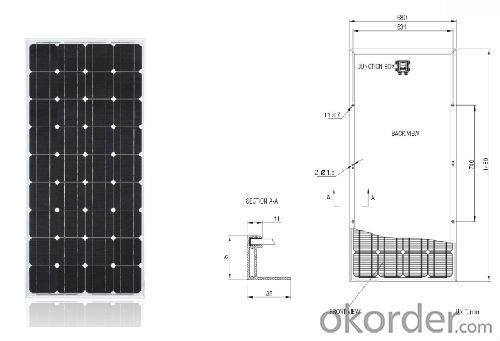
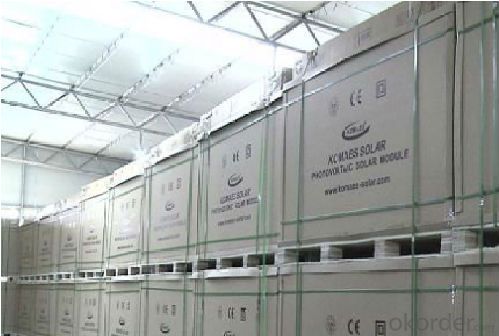
4. Solar Panel 150W with TUV IEC MCS INMETRO IDCOL SONCAP Certificates Specification
ELECTRICAL CHARACTERISTICS | ||||||
| Model Number | KM130(6) | KM135(6) | KM140(6) | KM145(6) | KM150(6) | |
| Maximum Power as per STC | Pmax(W) | 130 | 135 | 140 | 145 | 150 |
| Power Tolerance | % | ±3% | ||||
| Maximum Power Voltage | Vm(V) | 17.96 | 18.14 | 18.36 | 18.15 | 18.28 |
| Maximum Power Current | Im(A) | 7.26 | 7.45 | 7.65 | 7.99 | 8.21 |
| Open Circuit Voltage | Voc(V) | 21.6 | 21.74 | 21.96 | 21.72 | 21.9 |
| Short Circuit Current | Isc(A) | 7.83 | 8.04 | 8.17 | 8.69 | 8.93 |
| Maximum System Voltage | VDC | 1000 | ||||
| Cell Efficiency | % | 15 | 15.5 | 16.1 | 16.7 | 17.3 |
| Module Efficiency | % | 12.9 | 13.4 | 13.9 | 14.4 | 14.9 |
| Cells per Module | Pcs | 36 | ||||
| Cell Type | Monocrystalline silicon | |||||
| Cell Size | mm | 156 x 156 | ||||
| Bypass Diodes | Pcs | 10Amp, 2 pcs | ||||
| Max. Series Fuse Rating | A | 10A | ||||
| Temperature coefficient of Isc | %/°C | 0.05 | ||||
| Temperature coefficient of Voc | %/°C | -0.35 | ||||
| Temperature coefficient of power | %/°C | -0.47 | ||||
| NOCT- Nominal operating cell temperature | °C | 47 ± 2 | ||||
| Operating Temperature | °C | -40 ~ +85 | ||||
| MECHANICAL CHARACTERISTICS | ||||||
| Dimensions | mm | 1480 x 680 x 35 | ||||
| Weight | Kg | 11.6 | ||||
| Type of Junction Box | TUV certified, IP65 | |||||
| Cable Type, Diameter | - | |||||
| Connector | - | |||||
| Tempered Glass | 3.2 mm, high transmission, low iron | |||||
5. FAQ of Solar Panel 150W with TUV IEC MCS INMETRO IDCOL SONCAP Certificates
Q1. How long can we receive the product after purchase?
A1.In the purchase of product within three working days, We will arrange the factory delivery as soon as possible. The pecific time of receiving is related to the state and position of customers
Q2. Can we visit your factory?
A2:Surely, I will arrange the trip basing on your business schedule.
Q3:Which payment terms can you accept?
A3:T/T,L/C,Moneygram,Paypal are available for us.
- Q: Are solar panels a good investment?
- Yes, solar panels are a good investment. They offer long-term financial benefits through reduced electricity bills, potential tax incentives, and increased property value. Additionally, they contribute to a cleaner environment by reducing carbon emissions and dependence on fossil fuels.
- Q: Can solar panels be installed on a concert venue or entertainment facility?
- Yes, solar panels can be installed on a concert venue or entertainment facility. Solar panels can be mounted on rooftops, parking lots, or even integrated into the design of the venue itself. These installations can help offset the energy consumption of the facility, reduce carbon emissions, and potentially save on electricity costs in the long run.
- Q: I have noticed how solar panels cause a glare. Since I am not around solar panels all the time I relate it to when the sun reflects off another car and right into my eyes. So I always wonder if solar panels effect birds and/or animals due to the glare. If I am wrong and solar panels aren't this bad please tell me.
- My solar panels have provided a home for birds, they nest under them. I don't think we should worry about the glare of a solar panel when it is placed on a building that eliminated the habitat that used to be there. Glare is such a minor issue compared to eliminating food and shelter for many animals.
- Q: Can solar panels be used for air conditioning?
- Yes, solar panels can be used for air conditioning. Solar panels generate electricity from sunlight, which can be used to power air conditioning units. By using solar energy, homeowners and businesses can reduce their reliance on traditional electricity sources and decrease their carbon footprint. However, the efficiency and effectiveness of using solar panels for air conditioning may vary depending on factors such as the size of the solar system, location, and energy requirements of the air conditioning unit.
- Q: Hi there. I live in Colorado, and we obviously get a ton of snow there. I im looking into a solar power system for my home, and I am wondering if the snow will accumulate on the panels, or if, because of the energy passing through, it will melt on contact? By the way we get about 20' of snow each year, and it comes on often. I will also be putting them on my roof. Thanks for your help.
- The energy from the sun is converted to electicity, so there's very little heat produced. I doubt the snow would melt. Try finding a way to scrape it off or have them rotate so you can let the snow fall off.
- Q: I don't have a regulator connected as they are a little expensive for a pensioner, If I join the panels into line to the battery bank from the roof should that be OK.?
- Two things on a regulator: a) It will optimize the charge to the batteries - and thereby distribute the most possible power to your active circuits during the day. b) It will prevent the power from the panels from boiling (no kidding) the batteries - no small thing as they are the second largest investment you have after the panels themselves. This is much more critical if you have sealed or Zero-Maintenance batteries. I strongly suggest that you get a regulator as it will significantly lengthen battery life. Follow the directions on the regulator for optimum input voltage and it will let you know whether all the panels should be in series, parallel or series/parallel. But cutting to the chase, you can certainly gang up panels as needed.
- Q: Can solar panels be used to power a hospital?
- Yes, solar panels can be used to power a hospital. Solar energy can be harnessed through solar panels to generate electricity that can be used to power various equipment and facilities within a hospital, including lighting, medical devices, ventilation systems, and more. Using solar power can help reduce reliance on traditional energy sources, lower operating costs, and contribute to a more sustainable and environmentally-friendly healthcare system.
- Q: I am planning to buy some solar panels for my cabin and i want to be able to store the electricity. what kind of batteries should i get? i will be running simple things like a tv and radio. where can i buy these batteries? where should i look for the best batteries?
- Deep cycle, Golf Cart Batteries. You can get them at a battery store.
- Q: How do I hook up solar panels to my home
- Solar okorder / Here I didn't use an inverter since phones are DC powered electronic units. Hope I've been helpful.
- Q: Can solar panels be used for powering electric gates?
- Yes, solar panels can be used to power electric gates. Solar panels convert sunlight into electricity, which can be used to operate various electrical devices, including electric gates. This renewable energy source is an environmentally-friendly and cost-effective solution for powering gates in remote or off-grid locations.
Send your message to us
Monocrystalline Solar Panels 150W with TUV IEC MCS INMETRO IDCOL SONCAP
- Loading Port:
- China main port
- Payment Terms:
- TT or LC
- Min Order Qty:
- 20000 watt
- Supply Capability:
- 10000000 watt/month
OKorder Service Pledge
OKorder Financial Service
Similar products
Hot products
Hot Searches
Related keywords
